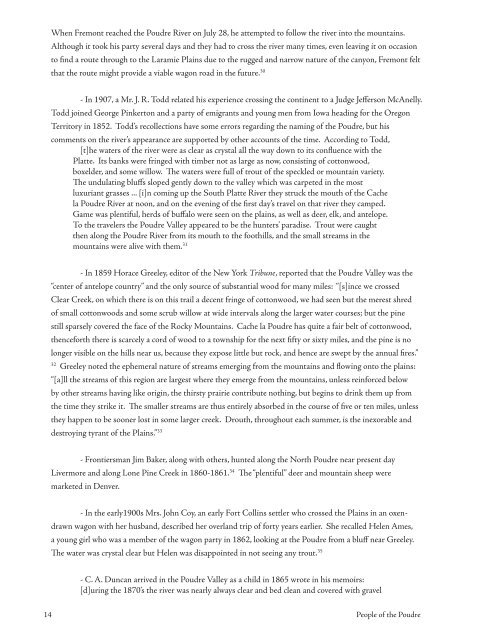People of the Poudre - Cache la Poudre National Heritage Area
People of the Poudre - Cache la Poudre National Heritage Area
People of the Poudre - Cache la Poudre National Heritage Area
You also want an ePaper? Increase the reach of your titles
YUMPU automatically turns print PDFs into web optimized ePapers that Google loves.
When Fremont reached <strong>the</strong> <strong>Poudre</strong> River on July 28, he attempted to follow <strong>the</strong> river into <strong>the</strong> mountains.Although it took his party several days and <strong>the</strong>y had to cross <strong>the</strong> river many times, even leaving it on occasionto find a route through to <strong>the</strong> Laramie P<strong>la</strong>ins due to <strong>the</strong> rugged and narrow nature <strong>of</strong> <strong>the</strong> canyon, Fremont feltthat <strong>the</strong> route might provide a viable wagon road in <strong>the</strong> future. 30- In 1907, a Mr. J. R. Todd re<strong>la</strong>ted his experience crossing <strong>the</strong> continent to a Judge Jefferson McAnelly.Todd joined George Pinkerton and a party <strong>of</strong> emigrants and young men from Iowa heading for <strong>the</strong> OregonTerritory in 1852. Todd’s recollections have some errors regarding <strong>the</strong> naming <strong>of</strong> <strong>the</strong> <strong>Poudre</strong>, but hiscomments on <strong>the</strong> river’s appearance are supported by o<strong>the</strong>r accounts <strong>of</strong> <strong>the</strong> time. According to Todd,[t]he waters <strong>of</strong> <strong>the</strong> river were as clear as crystal all <strong>the</strong> way down to its confluence with <strong>the</strong>P<strong>la</strong>tte. Its banks were fringed with timber not as <strong>la</strong>rge as now, consisting <strong>of</strong> cottonwood,boxelder, and some willow. The waters were full <strong>of</strong> trout <strong>of</strong> <strong>the</strong> speckled or mountain variety.The undu<strong>la</strong>ting bluffs sloped gently down to <strong>the</strong> valley which was carpeted in <strong>the</strong> mostluxuriant grasses ... [i]n coming up <strong>the</strong> South P<strong>la</strong>tte River <strong>the</strong>y struck <strong>the</strong> mouth <strong>of</strong> <strong>the</strong> <strong>Cache</strong><strong>la</strong> <strong>Poudre</strong> River at noon, and on <strong>the</strong> evening <strong>of</strong> <strong>the</strong> first day’s travel on that river <strong>the</strong>y camped.Game was plentiful, herds <strong>of</strong> buffalo were seen on <strong>the</strong> p<strong>la</strong>ins, as well as deer, elk, and antelope.To <strong>the</strong> travelers <strong>the</strong> <strong>Poudre</strong> Valley appeared to be <strong>the</strong> hunters’ paradise. Trout were caught<strong>the</strong>n along <strong>the</strong> <strong>Poudre</strong> River from its mouth to <strong>the</strong> foothills, and <strong>the</strong> small streams in <strong>the</strong>mountains were alive with <strong>the</strong>m. 31- In 1859 Horace Greeley, editor <strong>of</strong> <strong>the</strong> New York Tribune, reported that <strong>the</strong> <strong>Poudre</strong> Valley was <strong>the</strong>“center <strong>of</strong> antelope country” and <strong>the</strong> only source <strong>of</strong> substantial wood for many miles: “[s]ince we crossedClear Creek, on which <strong>the</strong>re is on this trail a decent fringe <strong>of</strong> cottonwood, we had seen but <strong>the</strong> merest shred<strong>of</strong> small cottonwoods and some scrub willow at wide intervals along <strong>the</strong> <strong>la</strong>rger water courses; but <strong>the</strong> pinestill sparsely covered <strong>the</strong> face <strong>of</strong> <strong>the</strong> Rocky Mountains. <strong>Cache</strong> <strong>la</strong> <strong>Poudre</strong> has quite a fair belt <strong>of</strong> cottonwood,<strong>the</strong>nceforth <strong>the</strong>re is scarcely a cord <strong>of</strong> wood to a township for <strong>the</strong> next fifty or sixty miles, and <strong>the</strong> pine is nolonger visible on <strong>the</strong> hills near us, because <strong>the</strong>y expose little but rock, and hence are swept by <strong>the</strong> annual fires.”32Greeley noted <strong>the</strong> ephemeral nature <strong>of</strong> streams emerging from <strong>the</strong> mountains and flowing onto <strong>the</strong> p<strong>la</strong>ins:“[a]ll <strong>the</strong> streams <strong>of</strong> this region are <strong>la</strong>rgest where <strong>the</strong>y emerge from <strong>the</strong> mountains, unless reinforced belowby o<strong>the</strong>r streams having like origin, <strong>the</strong> thirsty prairie contribute nothing, but begins to drink <strong>the</strong>m up from<strong>the</strong> time <strong>the</strong>y strike it. The smaller streams are thus entirely absorbed in <strong>the</strong> course <strong>of</strong> five or ten miles, unless<strong>the</strong>y happen to be sooner lost in some <strong>la</strong>rger creek. Drouth, throughout each summer, is <strong>the</strong> inexorable anddestroying tyrant <strong>of</strong> <strong>the</strong> P<strong>la</strong>ins.” 33- Frontiersman Jim Baker, along with o<strong>the</strong>rs, hunted along <strong>the</strong> North <strong>Poudre</strong> near present dayLivermore and along Lone Pine Creek in 1860-1861. 34 The “plentiful” deer and mountain sheep weremarketed in Denver.- In <strong>the</strong> early1900s Mrs. John Coy, an early Fort Collins settler who crossed <strong>the</strong> P<strong>la</strong>ins in an oxendrawnwagon with her husband, described her over<strong>la</strong>nd trip <strong>of</strong> forty years earlier. She recalled Helen Ames,a young girl who was a member <strong>of</strong> <strong>the</strong> wagon party in 1862, looking at <strong>the</strong> <strong>Poudre</strong> from a bluff near Greeley.The water was crystal clear but Helen was disappointed in not seeing any trout. 35- C. A. Duncan arrived in <strong>the</strong> <strong>Poudre</strong> Valley as a child in 1865 wrote in his memoirs:[d]uring <strong>the</strong> 1870’s <strong>the</strong> river was nearly always clear and bed clean and covered with gravel14 <strong>People</strong> <strong>of</strong> <strong>the</strong> <strong>Poudre</strong>


